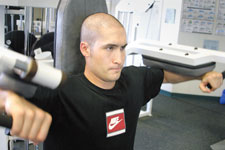Southern Foundation looks toward future of University

Andreas Adams, senior marketing major from Germany, works out at the Student Life Center. On average, Adams works out in the SLC two days a week.
Colleges and universities are going to new heights to stay competitive and draw students to their campuses.
The proposal for a new student recreation center, possibly attached to Billingsly Student Center, has made its way from a Student Senate idea to the drawing board.
“I was a skeptic at first, but after I looked into it, I was convinced it’s the right thing and good will come of it,” said Zach Odem, student senate president.
Doug Carnahan, dean of students, said the proposed facility would give students a reason to stay on campus and provide Missouri Southern with a much-needed social center.
Darren Fullerton, director of campus recreation and wellness, said remodeling the Lion’s Den brought students back to campus. The Lion’s Den would stay open later if the proposed student center were attached to Billingsly. The student health center will also be moved into the building.
The main highlight of the recreation center would be a fitness facility. Unlike existing fitness centers, this one would be open to all students and not exclusively athletes.
“The Student Life Center doesn’t cut it; there are no showers or changing facilities,” Fullerton said. “It’s not friendly to those off campus.”
Keeping the fitness center open to all students is one of the reasons the facility has been suggested as an addition to BSC.
“The best thing about a student recreation center is the sports department will not be able to restrict students’ access to the facility,” Odem said. “If we attach to Young it would be too tempting to restrict student use and use student funds.”
Fullerton said more than 32 percent of students polled belong to a fitness club. Club dues for students average $25-$30 per month.
Dr. Terri Agee, vice president for academic affairs, met with seven architects at a proposal meeting Oct. 2.
“The firms will be submitting proposals for a feasibility study,” Agee said.
She said the request for proposal committee, chaired by Bob Harrington, director of the physical plant, will review the proposals and invite three finalists back to the University to give presentations.
“We want to approach this in a quality manner, and it should yield quality results,” Agee said. “When all that is said and done, hopefully we will have a master plan with regard to the recreation center and facilities.”
University President Julio León said Southern is getting ideas by looking to what other institutions have done.
Fullerton said one such institution is the University of Tulsa.
Demographically similar to the University, TU has approximately 4,000 students on campus, more than 2,000 of which pass through the fitness center every day, he said.
Carnahan said Arizona State University tracked students who were regular users of the rec center there and discovered these students had higher graduation rates.
“We want students to go over anytime on their own or expand intramurals that are now limited because of space, lights and the fields,” Fullerton said.
Cost is one factor receiving a significant amount of attention in planning the center.
“Any speculation to cost and fees are of pure speculation and totally unwarranted,” León said.
Present plans call for a portion of the financing necessary to cover the expansion to come from a student activities fee.
“The fee per semester will be minimal especially in consideration of what the students will get out of the building,” Odem said.
The exact cost of the fee, however, has not been determined.
Carnahan said part-time students would also contribute to the project through the activity fee.
Presently, part time students do not pay the same fees as full time students.
“Anybody who says they know how much it is going to cost does not know,” Odem said.
Curt Betebenner, director of the Missouri Southern Foundation, said he is talking to someone about donating $1 million specifically for the student recreation center.
Larry Hickey is the honorary chairman of the Missouri Southern Endowment and Capital Campaign. He said people should support the University financially.
Hickey grew up during the depression and worked his way through school.
He said people would donate money to the school when they didn’t have enough to eat.
“To see the University prosper, it is important the alumni give when they can,” Osborn said. “It contributes to the enthusiasm of the University.”
Your donation will support the student journalists of Missouri Southern State University. Your contribution will allow us to purchase equipment and cover our annual website hosting costs.



























